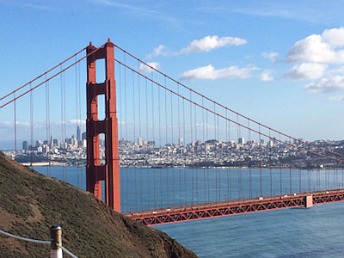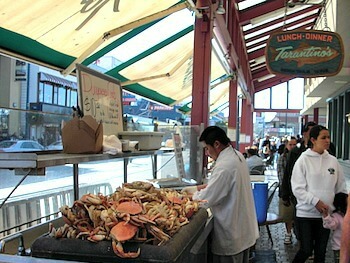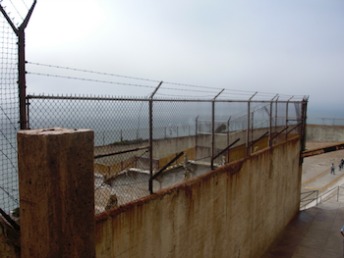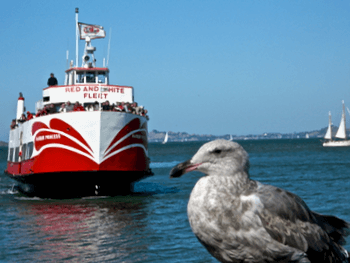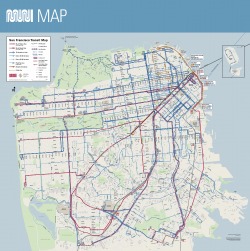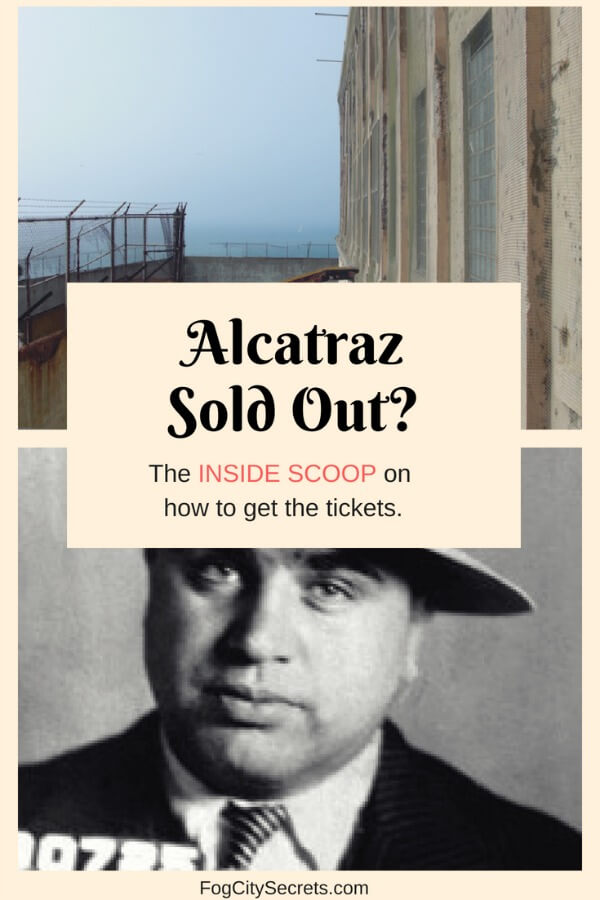- Home
- Getting Around San Francisco
- Cable Cars
Riding a Cable Car in San Francisco
Riding the iconic San Francisco cable cars is one of the best things to do in the city. Why are most of the people on the car smiling? Because it really is a blast!
This is a local's guide to riding the cable cars: how it all works and my tips for getting the most out of it.
Here are the most important things to know before getting on the cable cars...
- How to pay
- How to get on and off
- Which route to take
- How to avoid the lines
- How to save money on the tickets
Jump to...
San Francisco Cable Car Tickets
Cable Car Fares
One ride on the San Francisco cable car now costs $8: same price for everyone.
Only exceptions: seniors 65+ pay $4 before 7 am or after 9 pm.
Note: you pay $8 every time you get on. They don't give transfers.
Also, you have to get off at the end of the route. No roundtrips.
How to pay for the cable car ride
Pay after you get on. There are two people running each cable car. One is the grip man (or woman) who operates the car, and the other handles the payments and helps people get on board.
They take payments after everyone is on board. So once you're in your place and the car is moving, you'll be asked for your fare (cash, ticket or pass).
Exception: if you're getting on at one of the cable car turnarounds at Powell & Market, Hyde & Beach, or Bay & Taylor, you have to have a ticket or pass before you board (if it's between 8 am and 5 pm). In other words, they don't take cash at those turnarounds.
But there's a ticket booth at each of those turnarounds where you can buy the tickets or passes. Or just get on at a stop further away and pay cash.
Payment options
- Cash: they say exact change only on the official site, but I have seen them make change for smaller bills ($20 bills and below). I wouldn't count on it, though.
- Paper tickets: purchase these one-way tickets at the ticket booths located near the cable car turnarounds at each end of the route.
- MuniMobile app: download the MuniMobile app and you can purchase individual tickets for your self or your group, or purchase one of the many transit passes available in SF.
- Clipper Card: a local card that allows you to load cash or passes onto it and have it scanned for payment. A mobile version of the card has been recently introduced.
- 1, 3 and 7-day transit passes: get unlimited travel on all SF buses, trolleys and cable cars. See below for pass info.
The California Line doesn't have a ticket booth, so it's cash or passes for those cable cars (unless you bought the tickets elsewhere).
Tip: for a brief visit to SF, using the MuniMobile app is probably the easiest way to pay fares or get transit passes.
You don't need the carry the right amount of cash (and the buses and streetcars do require exact change) and you can do everything online instantly. Plus you can buy all the family's tickets on one MuniMobile account.
You can download the app on either iOS or android phones.
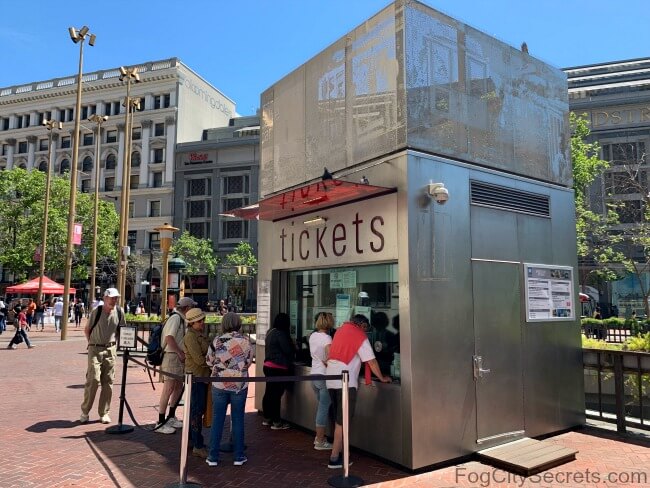 Ticket booth at the Powell and Market Street turnaround.
Ticket booth at the Powell and Market Street turnaround.The ticket booth above sells one-way, cable car tickets, as well as adult Clipper Cards, and the 1, 3 and 7-day SF Visitor Passports.
The ticket booth is on Market Street at Powell, right next to the exit from the underground Muni and BART trains, Powell Stop for both.
I may earn a small commission if you make a purchase through some of the links on this page, at no extra cost to you. This helps me provide all the free information I post on this website. Thank you for your support!
Saving money on the tickets
Cable cars are on the expensive side if you plan to make more than a couple of trips on them, especially if you also plan to get around SF on the buses and trolleys during your stay.
One solution is getting a transit pass which gives you unlimited travel on all four of the public transportation modes in San Francisco: buses, street cars, antique F-line trolleys and the cable cars.
The most popular transit pass is the:
- SF Visitor Passport (1, 3 or 7-day transit passes)
SF Visitor Passport. Purchase these at the ticket booths at the cable car turnarounds, the underground Muni ticket machines under Market Street, or at a few retail locations.
Also, you can purchase them online with via the MuniMobile app, or add them to your Clipper Card (plastic or virtual).
Visitor Passports prices:
- 1 day: $13
- 3 days: $31
- 7 days: $41
San Francisco CityPass. You used to be able to get a pass for 3 days of unlimited travel on all the SF buses, trolleys and cable cars, along with entry to four popular SF attractions.
As of March 1, 2020, the SF CityPass no longer includes the 3-day transit pass, but you can still purchase the two passes separately. See the SF CityPass for more info and booking.
For a detailed guide to all the various transit passes available in SF, how to get them, and advantages & disadvantages of each, see my tips on getting around San Francisco.
SF Cable Car Hours
Cable Car schedule: all lines are now running daily, 7:00 am to 10:30 pm.
The cable cars run about every 10 minutes, on average. A little closer together in the morning and a bit farther apart in the evening, but generally within an 8 to 12 minute time span.
There's a handy app, NextBus, that tells you the arrival times of upcoming buses and streetcars, but unfortunately it doesn't work with the cable cars.
Visitors will notice that when the cable cars arrive at the end points, they can stack up three or more deep sometimes, even though there's a long line of people waiting for them.
They kind of look like they're just lounging around, but they have to keep to the schedule and coordinate with the cars on the other lines that are sharing the same track, so they're doing what they need to do.
How to ride the cable cars
Getting on at the starting points
Most people get on at the turnaround points at either end of the cable car lines.
You'll notice the long lines waiting to get on, especially at the Powell & Market and the Hyde & Beach turnarounds for the popular routes that run between Fisherman's Wharf and downtown San Francisco.
When it's your turn to get on, you can sit anywhere there are seats available or stand and hold onto a pole at the designated standing spots.
You can also walk around to the other side of the car to access the seats and standing spots on that side.
If you are one of the last to get on, the best spots (outside seats and pole hanging) will probably be taken and only the inside seats will be available.
Given the long lines, people are often surprised that they don't fill the cars, and leave quite a few seats empty (mainly inside the car). That's so people at subsequent stops have a chance to get on the cars, and that leads to the secret for avoiding the lines!
Getting an "outside" seat
If you're not towards the front of the next group to get on, you can still maneuver to get a "good" seat. You can let some of the people behind you get on, and wait for the next car.
Or when the boarding begins, go immediately around to the other side of the car and get on there.
Getting on at other stops
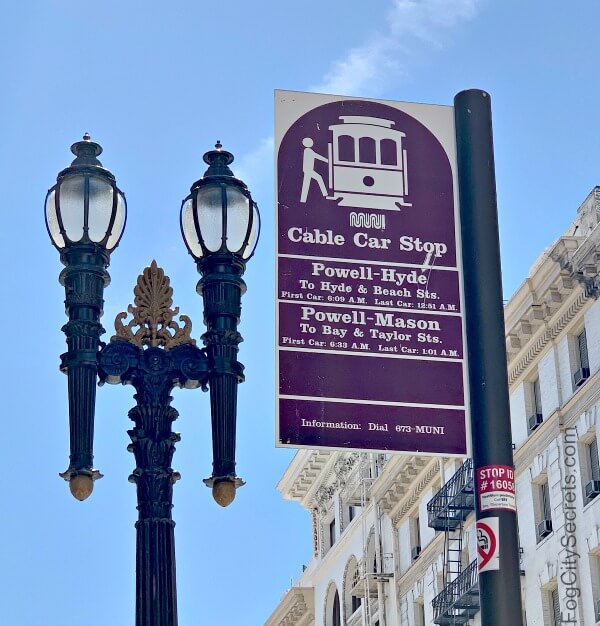 Cable car stop
Cable car stopAll along the route, about every block or two, there are cable car stops marked with a purple sign. If there's room, and there almost always is, they will stop and let you board.
Wait at the curb and wave at the car when it's about half a block away. When it stops, get on and find a place. Then you'll pay the fare or show your pass.
Depending on how busy the season is, or the time of day, or who has just gotten off, you may or not get one of the coveted outside seats. There is a pretty good chance of getting one of the pole-hanging spots, though.
Getting off the cable car
Two things to know:
- They don't stop at every stop unless asked. Tell the grip man that you want to get off about a half block before the stop (the cords above the seats just ring the bell, they don't request a stop like they do on buses and streetcars). Say "next stop, please".
- Be very careful getting off. You will be stepping right into a lane of traffic and San Franciscans drive pretty fast. Getting off at the end of the line is the safest.
Avoiding the long lines
The longest lines are at the two ends of the Powell-Hyde line: Powell & Market and Hyde & Beach.
Here's where you don't want to stand in line:
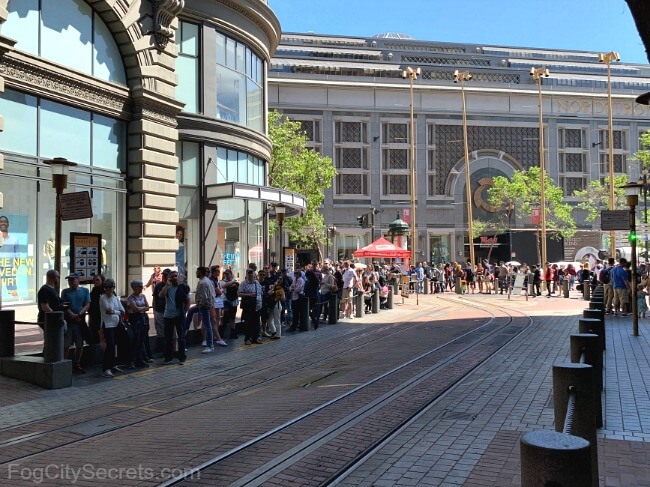 Cable car line at Powell & Market
Cable car line at Powell & MarketAnd this was in April, not the busiest season. The line above had probably over an hour wait time.
I was standing here for only ten minutes, just watching, and the sound of the erhu player squeaking the same four notes almost sent me round the bend!
But this doesn't have to be you in the line.

Insider Tips:
- Walk up one block. They don't fill up the cars at the turnaround points. So if you just walk up to the next cable car stop, you can usually get right on. If not on the first car, then almost certainly on the next one.
- Take the Powell-Mason Line back. When you're ready to leave Fisherman's Wharf and return to Union Square/downtown, walk over to the Bay & Taylor starting point for the Powell-Mason line. It has a much shorter line than the one at the Powell-Hyde turnaround at Hyde and Beach.
- Ride the California Line. If you're not set on riding to Fisherman's Wharf or getting off at Lombard Street, the California Line is fairly empty and will give you a great ride up and over Nob Hill. There's usually no waiting in line for those cable cars.
Which is the best route?
The cable car routes come in three flavors, but they all go up and down steep hills and give you an exhilarating ride!
The two lines leaving from Powell and Market Streets both take you to Fisherman's Wharf, but take different routes to get there.
The California Line runs perpendicular to the other two lines.
The Three Cable Car Routes
- Powell & Hyde: leaves from Market Street at Powell, near Union Square, and ends at Hyde and Beach Streets in Fisherman's Wharf.
- Powell & Mason: also leaves from Market and Powell, and ends at Bay and Taylor Streets, a couple of blocks from Fisherman's Wharf.
- California Line: runs from the end of Market Street (at Drumm St.) to Van Ness St., up to the top of Nob Hill.
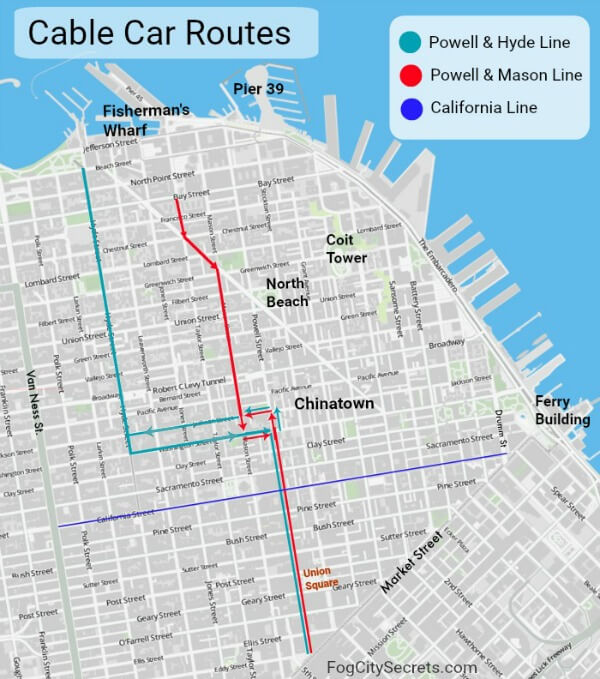
The Powell- Hyde Line
This is the most popular line, largely because it takes you directly to Fisherman's Wharf and you get great views of Lombard Street, Coit Tower, and Alcatraz.
The cable car stops at the top of the crooked block of Lombard Street, where you can get a great picture of the city and bay, with Coit Tower in the distance.
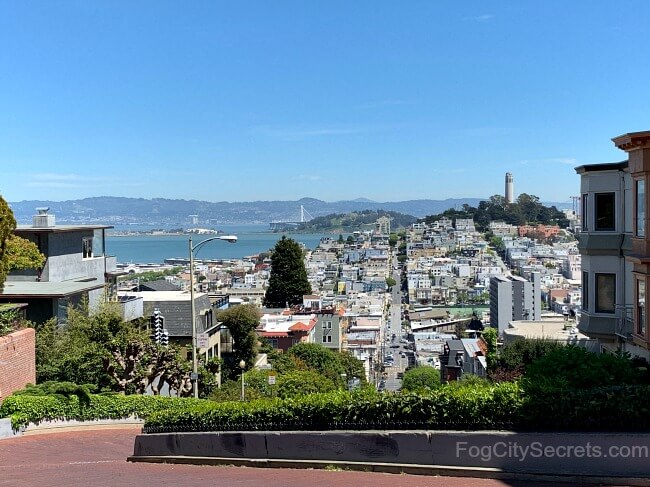 Stopping at the top of Lombard Street
Stopping at the top of Lombard StreetIf you get off here, you can walk down Lombard and take photos of the cars coming down the eight switchbacks among the blooming hydrangeas.
If you don't want to walk back up Lombard to catch the cable car again, you can walk over to Fisherman's Wharf. Go left on Leavenworth Street (at the bottom of Lombard) and walk three blocks to the wharf.
If you continue on with the cable car to Fisherman's Wharf, you'll go down a nice steep hill where you get a great view of Alcatraz.
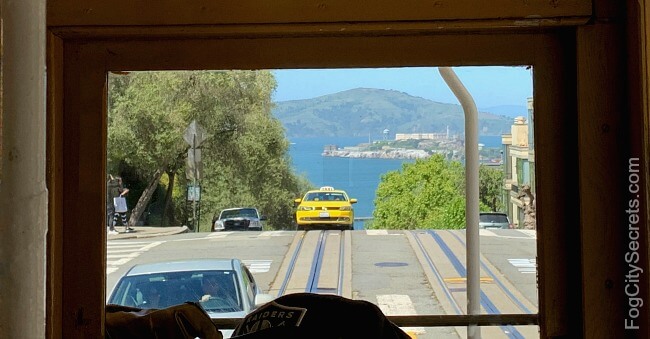 Steep hill approaching
Steep hill approachingWhere to sit: for the best views, sit on the right side on the way to Fisherman's Wharf, and on the left side heading back to Union Square.
Takes about 20 minutes.
The Powell-Mason Line
I think this is a somewhat under-appreciated cable car line. The Powell-Mason line is a good line to take to Fisherman's Wharf if you don't want to fight the crowds. Even if you wait in the long line at the turnaround, you'll find people letting you go ahead so they can take the other line.
The hills aren't quite as steep, or the views as amazing as the other Powell line, but you'll get some nice views of the Transamerica Pyramid and go right through the heart of North Beach, our Little Italy.
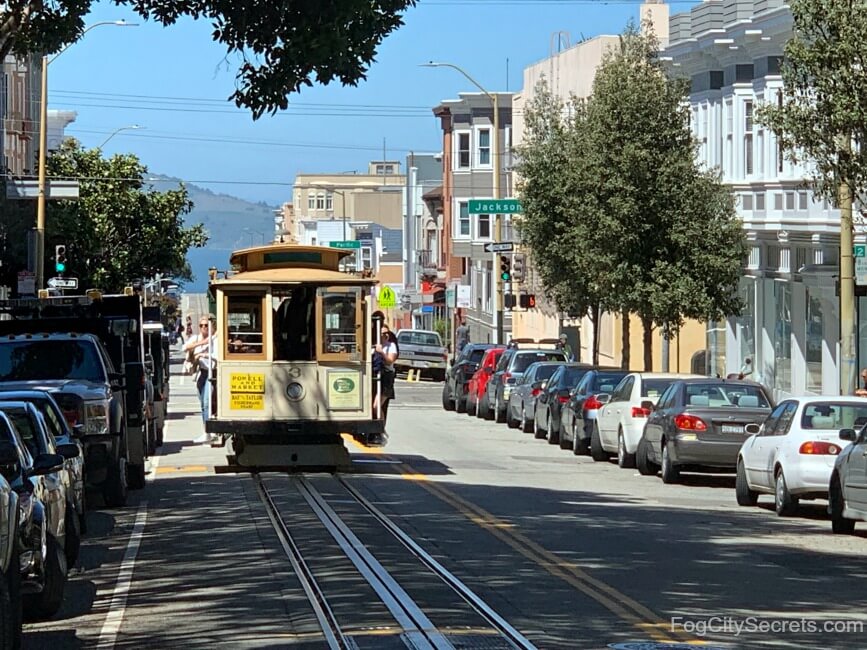 Charming neighborhood views
Charming neighborhood viewsThis is the best route to take back to downtown when you're ready to leave Fisherman's Wharf because of the much shorter line.
Takes about 17 minutes.
The California Line
This is sort of the forgotten cable car line. Most people ride the two lines that leave from Powell and Market, so this one is much easier to get on; usually there's no wait. There are more locals on it as well.
It doesn't take you to Fisherman's Wharf like the other two, but it climbs one of the steepest hills, Nob Hill, up to a pair of historic, luxury hotels, the Mark Hopkins and the Fairmont, two San Francisco classics.
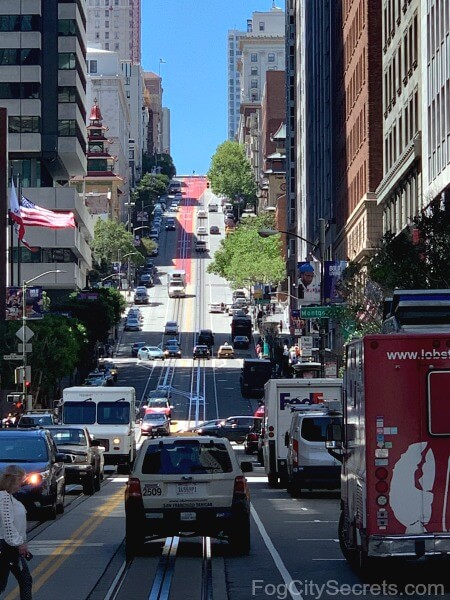 Looking up to Chinatown and Nob HIll
Looking up to Chinatown and Nob HIllGrace Cathedral is also on top of Nob Hill, right on the cable car line: a beautiful old church with a popular labyrinth.
There are two cool and historic bars at the top here: Top of the Mark, a classy cocktail lounge with incredible city views, in the Mark Hopkins Hotel, and the Tonga Room, in the Fairmont Hotel, one of the city's original tiki bars. This is a fun line to ride after dark.
Takes about 16 minutes.
You'll also pass through Chinatown at the picturesque intersection between the Sing Chong and Sing Fat buildings, with a good look down the main street and hanging lanterns of Grant Avenue.
Seating on the cable cars
The Powell-Hyde and Powell-Mason lines use the same style of cable car. Half of the car has an enclosed compartment with wooden benches, and the other half has rows of wooden benches facing outward.
In front of the benches outside are steps for people to stand on, with poles for hanging on.
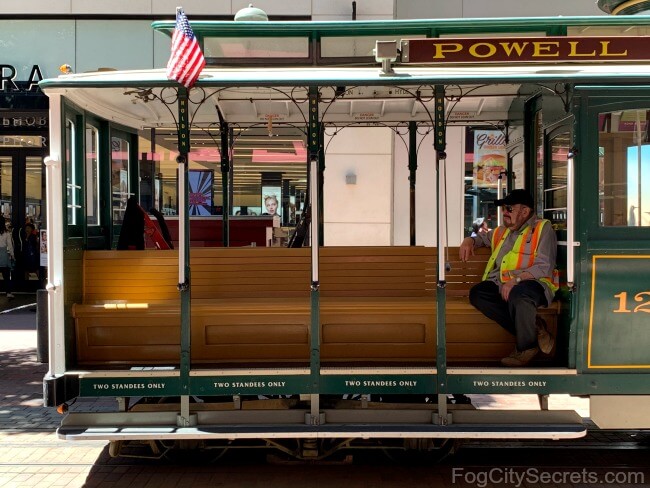 Outside seating on the Powell car
Outside seating on the Powell carThere are 14 places available for hanging on to the Powell line cars, 8 on one side and 6 on the other. It's usually possible to snag one of these places (the most fun ones, I think).
These cars can only go in one direction, hence the rotating platform that has to be manually turned to get them facing the right direction for the return trip.
The California line has a larger car, with an inside compartment in the middle and outside seating on both ends, also with steps for standing and hanging on.
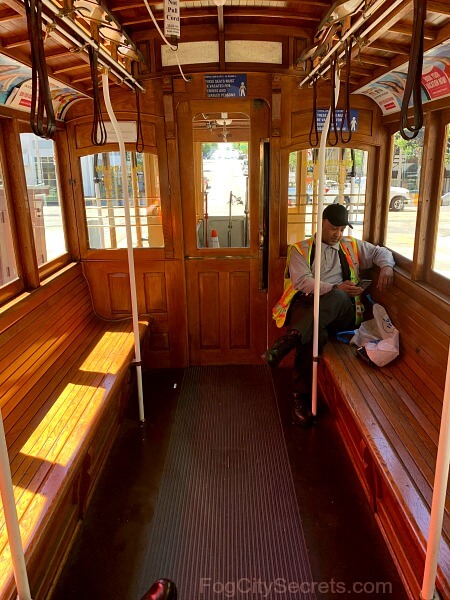 Inside the California car
Inside the California carThe California cars can go in both directions so they don't have to be turned around.
Which are the best seats?
I think the best ride, if you're able, is to stand and hang on to the pole. You get an unobstructed view (unlike the people you're standing in front of), feel the wind in your hair, and can appreciate how close you are to the other traffic on the street!
Of course, riding there requires you to be more vigilant so you don't get bumped by the other vehicles traveling on the street. You realize it isn't an amusement park ride when city traffic is zooming by your body only 12 inches away! But that makes it all the more exciting;)
The next best seats are the outside benches. Much better views than the inside seats, especially when it gets crowded and there are also people standing inside.
And if you can get the seats all the way at either end of the car, the views are better and you can really see how steep those streets are.
The ride is a bit rough; it's the same ride that people had in the late 1800's. The grip men keep reminding riders to "hold on", and for good reason, especially around the corners!
History of the SF Cable Cars
Beginning. The cable car system was invented in 1869 by Andrew Hallidie, an engineer who had also designed a transport system for carrying loads of rocks out of the mines up in the Gold Country.
Legend has it that he was inspired to try to design a transportation system for San Francisco's steep hills after witnessing a terrible accident in which horses pulling a street car up a hill slipped and were dragged to their deaths.
Success. San Francisco's system launched in 1873. The cable cars worked so well and were so much more efficient than the horse drawn cars, they caught on quickly, and spread to other cities like New York, Chicago and Los Angeles.
At the peak, San Francisco had over 70 miles of cable car tracks carrying passengers throughout the city.
The end...almost. Two things almost delivered a knockout blow to the SF cable cars. Electric streetcars had been introduced to San Francisco in 1892 and were rapidly replacing the more expensive and much less efficient cable cars. Then disaster struck: the 1906 earthquake destroyed much of the cable car system along with most of San Francisco.
The extensive cable car system was reduced to only three lines, running on the steepest streets that weren't as practical for the new streetcars.
27 cable cars survived the terrible fire, having been stored outside the fire zone, and they were put back in use after tracks were repaired.
Cool fact: these original 27 cars are still running on San Francisco streets, along with some built more recently.
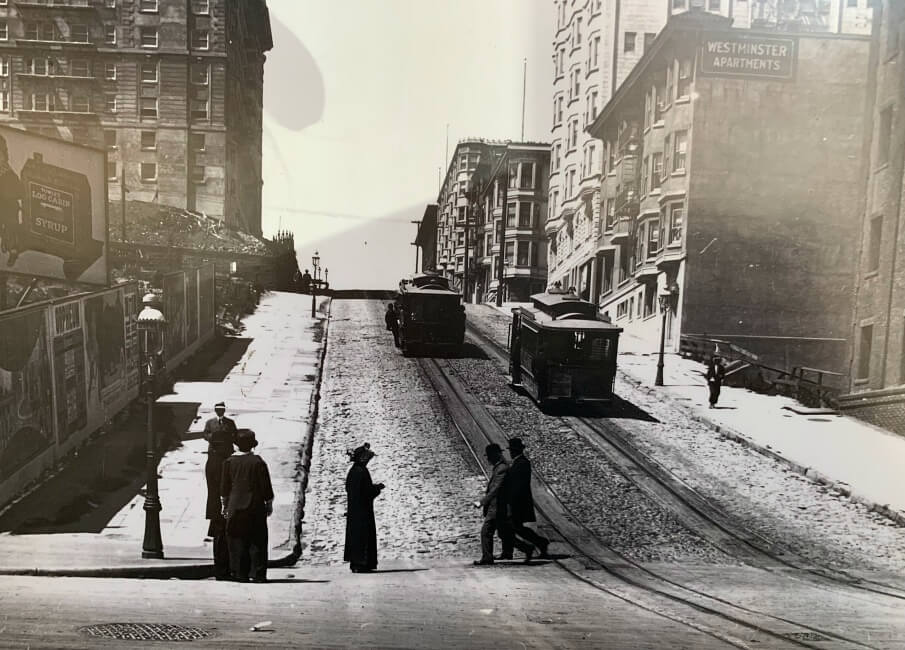 Cable cars on Powell Street, 1914
Cable cars on Powell Street, 1914Battle to save the cable cars. In 1947, San Francisco's mayor wanted to "modernize" the city and do away with the old fashioned cable cars. But a fierce battle followed when citizens formed action groups to save the iconic cars, and ultimately, locals voted on a referendum the same year to keep the cars running.
The San Francisco cable cars were designated a National Historic Landmark in 1962. They were the first cable cars in the world and now they're the only remaining manually-operated cable car system still in use.
The current system. Over 13 million people ride the cable cars every year. San Francisco has 4.7 miles of tracks, on three lines, down from 75 miles at the high point.
The cars are all powered by a collection of giant, 8-foot wheels that drive the cables pulling the cars. The machinery is located in the Cable Car Barn, which also contains the popular Cable Car Museum (see below). The power is now electric, though originally it was driven by a steam engine.
How do the cable cars work? The cars have no engines and rely on a clamp that grabs the moving cable running under the street.
The cables travel underground at a constant speed of 9.5 miles per hour. The cable car grip man regulates the speed by how tightly he grips the cable. There's also a braking system on the cars.
The cars are fairly high maintenance. Because the pressure and friction is so great, both the brakes and grip mechanism have parts that wear down and have to be replaced every 2 to 3 days. The cables themselves also wear out and need periodic repairs and replacement.
How many cars are there? Altogether, there are 40 cable cars, of which about 28 are in use during the day. The cars run from around 6 am until around 12:30 at night. At the end of the day, they trundle back to the Cable Car Barn where they spend the night.
The cables themselves run 19 hours a day.
The Cable Car Museum
This is a really fun museum to drop into. Entry is free. The museum is also the Cable Car Barn where the cars spend the night, as well as the power house that runs the cables for all three lines.
Along with several of the historic cable cars, there is a lot of information about the development of the cable cars, how they work, and how the vast system of cable cars covering San Francisco dwindled to a small remnant, and almost disappeared entirely in 1947.
You can see Car #8 there, the only cable car left from the original ones built in 1873; it's the oldest cable car in the world.
The best part, however, is you can stand and look down at the massive, 8-foot wheels that drive the cables. The working mechanism of the cable system is exposed and you can see the four lines of cable being hauled through the system.
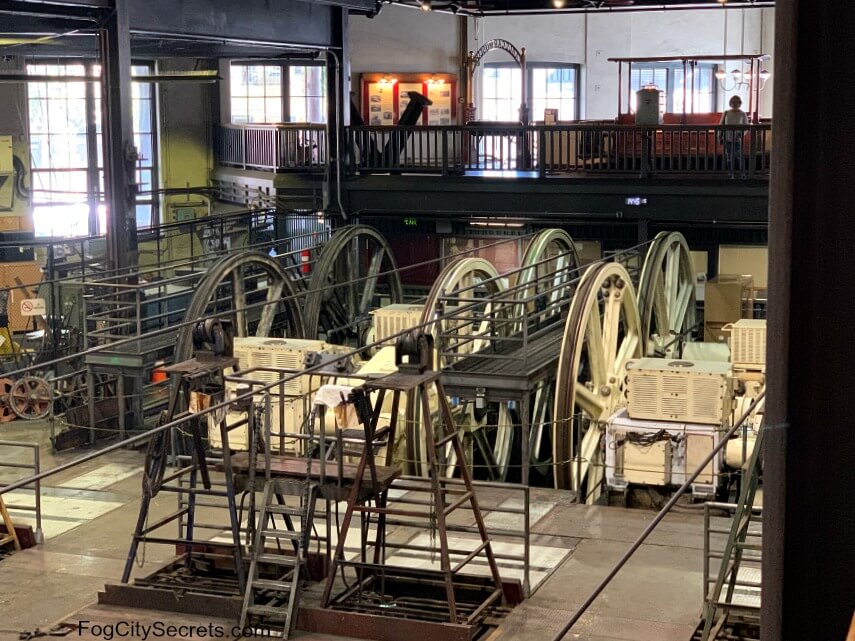 The power house running the cables
The power house running the cablesThere are four separate lines because the Powell line is a shared line, and the other three lines (Hyde, Mason and California) are specific to just one cable car line.
Amazing that these cables are pulling 28 heavy cable cars through the city, and up the steep hills!
You can also go into the basement and see the massive wheels pulling the cables underground.
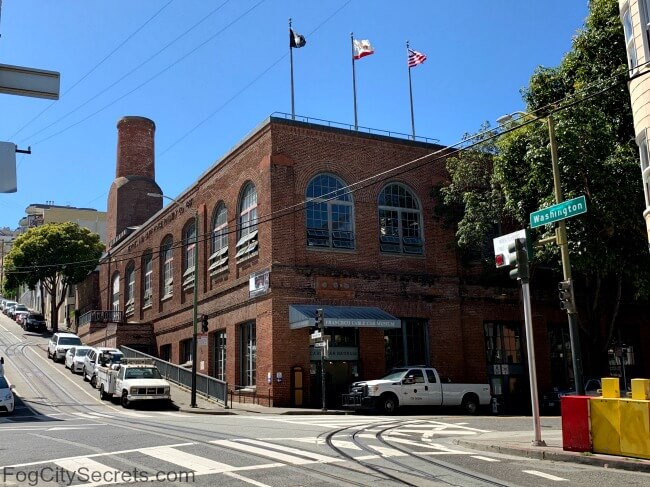 Cable Car Museum and Powerhouse
Cable Car Museum and PowerhouseThe exterior of the building is the original car barn and power house from 1888.
Location. 1201 Mason Street, between Jackson and Washington, where the two Powell lines split on their journey to Fisherman's Wharf, near Chinatown.
Getting there: both Powell lines stop here, both coming and going, so taking a cable car gets you right there. Otherwise, the 30-Stockton bus runs along Stockton Street, two blocks down from the museum.
Street parking is tough in this neighborhood. Aim for a garage in Chinatown (see Chinatown parking).
Museum Hours. Open daily. April-October: 10 to 6, November-March: 10 to 5.
The cable cars have inspired artists...
At some point, the cable car system was transformed from a means of transportation through San Francisco to an icon for the city and an extremely popular tourist attraction.
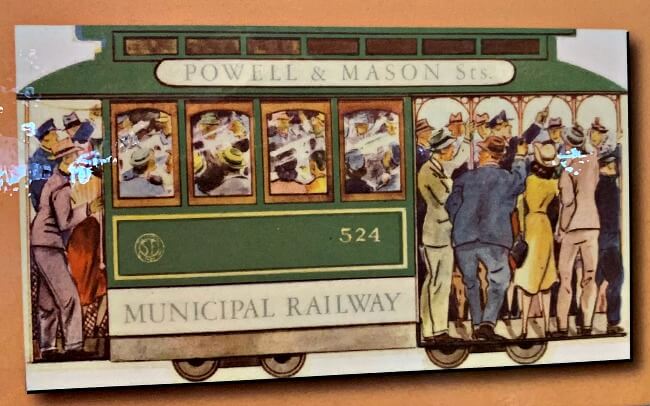 Vintage postcard
Vintage postcardThe hippie vibe of the 1960's and 1970's inspired some fanciful renditions of the city and its cable cars.
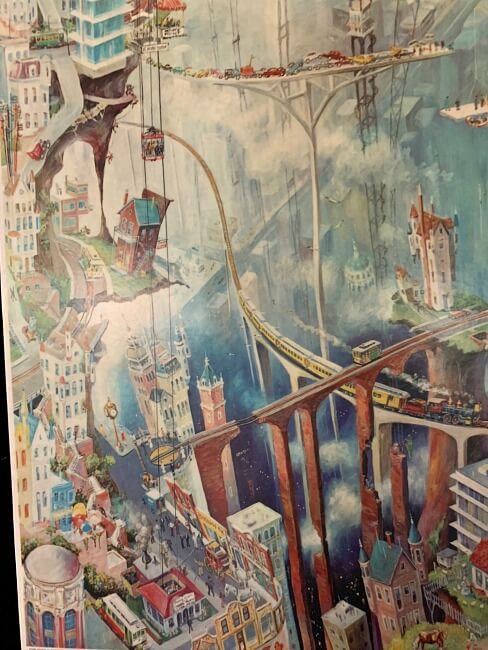 Surrealistic view of San Francisco, by Albert Tolf
Surrealistic view of San Francisco, by Albert TolfLearn about taking the other forms of public transportation in San Francisco. Check out our local tips on riding the buses, trolleys, ferries, and more.
Can you stay on the cable car when it reaches the end of the line and continue riding in the other direction?
Can you stay on the cable car when it reaches the end of the line and continue riding in the other direction?
No, they make you get off when the cable car comes to the end of the line. You have to buy another ticket and get in line again if you want to get back on.
Can you get a transfer when you get off the cable car to use to take another ride?
Can you get a transfer when you get off the cable car to use to take another ride?
No, every time you get on a cable car, you have to buy a ticket.
How much is a ticket for the cable cars?
How much is a ticket for the cable cars?
$8 for everyone. Seniors can pay $4 before 7 am or after 9 pm.
Can age 18 and under ride cable cars for free?
Can age 18 and under ride cable cars for free?
No, kids have to pay $8 as well. On SF muni buses and streetcars (trolleys), 18 and under ride free.
More to explore...
Share this page:

